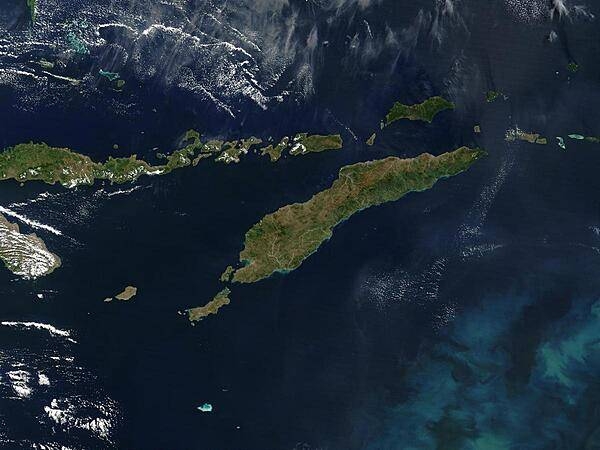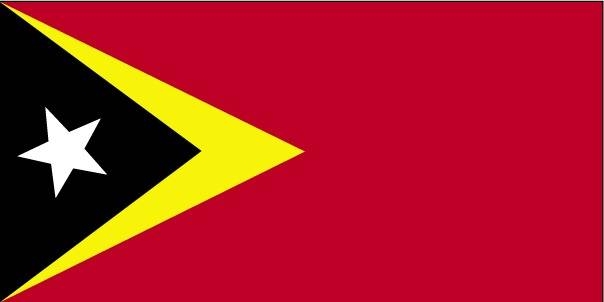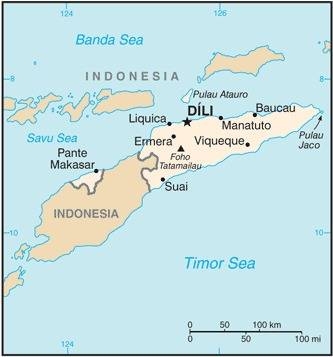Timor-Leste
Introduction
Background
Timor was actively involved in Southeast Asian trading networks for centuries, and by the 14th century exported aromatic sandalwood, slaves, honey, and wax. A number of local chiefdoms ruled the island in the early 16th century when Portuguese traders arrived, chiefly attracted by the relative abundance of sandalwood on Timor; by mid-century, the Portuguese had colonized the island. Skirmishing with the Dutch in the region eventually resulted in an 1859 treaty in which Portugal ceded the western portion of the island. Imperial Japan occupied Portuguese Timor from 1942 to 1945, but Portugal resumed colonial authority after the Japanese defeat in World War II. East Timor declared itself independent from Portugal on 28 November 1975 and was invaded and occupied by Indonesian forces nine days later. It was incorporated into Indonesia in July 1976 as the province of Timor Timur (East Timor). An unsuccessful campaign of pacification followed over the next two decades, during which an estimated 100,000 to 250,000 people died. In an August 1999 UN-supervised popular referendum, an overwhelming majority of the people of Timor-Leste voted for independence from Indonesia. However, in the next three weeks, anti-independence Timorese militias - organized and supported by the Indonesian military - commenced a large-scale, scorched-earth campaign of retribution. The militias killed approximately 1,400 Timorese and displaced nearly 500,000. Most of the country's infrastructure, including homes, irrigation systems, water supply systems, and schools, and nearly all of the country's electrical grid were destroyed. On 20 September 1999, Australian-led peacekeeping troops deployed to the country and brought the violence to an end. On 20 May 2002, Timor-Leste was internationally recognized as an independent state.
In 2006, internal tensions threatened the new nation's security when a military strike led to violence and a breakdown of law and order. At Dili's request, an Australian-led International Stabilization Force (ISF) deployed to Timor-Leste, and the UN Security Council established the UN Integrated Mission in Timor-Leste (UNMIT), which included an authorized police presence of over 1,600 personnel. The ISF and UNMIT restored stability, allowing for presidential and parliamentary elections in 2007 in a largely peaceful atmosphere. In February 2008, a rebel group staged an unsuccessful attack against the president and prime minister. The ringleader was killed in the attack, and most of the rebels surrendered in April 2008. Since the attack, the government has enjoyed one of its longest periods of post-independence stability, including successful 2012 elections for both the National Parliament and president and a successful transition of power in February 2015. In late 2012, the UN Security Council ended its peacekeeping mission in Timor-Leste and both the ISF and UNMIT departed the country.
Visit the Definitions and Notes page to view a description of each topic.
Geography
Location
Southeastern Asia, northwest of Australia in the Lesser Sunda Islands at the eastern end of the Indonesian archipelago; note - Timor-Leste includes the eastern half of the island of Timor, the Oecussi (Ambeno) region on the northwest portion of the island of Timor, and the islands of Pulau Atauro and Pulau Jaco
Geographic coordinates
8 50 S, 125 55 E
Map references
Southeast Asia
Area - comparative
slightly larger than Connecticut; almost half the size of Maryland
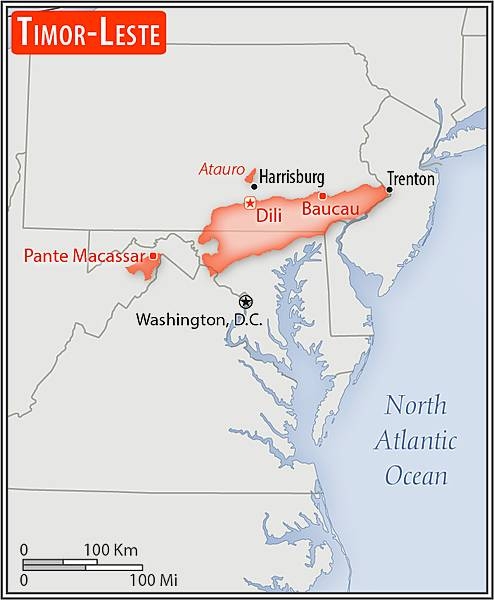
Land boundaries
total: 253 km
border countries (1): Indonesia 253 km
Coastline
706 km
Maritime claims
territorial sea: 12 nm
contiguous zone: 24 nm
exclusive fishing zone: 200 nm
Climate
tropical; hot, humid; distinct rainy and dry seasons
Terrain
mountainous
Elevation
highest point: Foho Tatamailau 2,963 m
lowest point: Timor Sea, Savu Sea, and Banda Sea 0 m
Natural resources
gold, petroleum, natural gas, manganese, marble
Land use
agricultural land: 25.1% (2018 est.)
arable land: 10.1% (2018 est.)
permanent crops: 4.9% (2018 est.)
permanent pasture: 10.1% (2018 est.)
forest: 49.1% (2018 est.)
other: 25.8% (2018 est.)
Irrigated land
350 sq km (2012)
Population distribution
most of the population concentrated in the western third of the country, particularly around Dili
Natural hazards
floods and landslides are common; earthquakes; tsunamis; tropical cyclones
Geography - note
Timor comes from the Malay word for "east"; the island of Timor is part of the Malay Archipelago and is the largest and easternmost of the Lesser Sunda Islands; the district of Oecussi is an exclave separated from Timor-Leste proper by Indonesia; Timor-Leste has the unique distinction of being the only Asian country located completely in the Southern Hemisphere
People and Society
Nationality
noun: Timorese
adjective: Timorese
Ethnic groups
Austronesian (Malayo-Polynesian) (includes Tetun, Mambai, Tokodede, Galoli, Kemak, Baikeno), Melanesian-Papuan (includes Bunak, Fataluku, Bakasai), small Chinese minority
Languages
Tetun Prasa 30.6%, Mambai 16.6%, Makasai 10.5%, Tetun Terik 6.1%, Baikenu 5.9%, Kemak 5.8%, Bunak 5.5%, Tokodede 4%, Fataluku 3.5%, Waima'a 1.8%, Galoli 1.4%, Naueti 1.4%, Idate 1.2%, Midiki 1.2%, other 4.5% (2015 est.)
note: data represent population by mother tongue; Tetun and Portuguese are official languages; Indonesian and English are working languages; there are about 32 indigenous languages
Religions
Roman Catholic 97.6%, Protestant/Evangelical 2%, Muslim 0.2%, other 0.2% (2015 est.)
Demographic profile
Timor-Leste’s high fertility and population growth rates sustain its very youthful age structure – approximately 40% of the population is below the age of 15 and the country’s median age is 20. While Timor-Leste’s total fertility rate (TFR) – the average number of births per woman – decreased significantly from over 7 in the early 2000s, it remains high at 4.3 in 2021 and will probably continue to decline slowly. The low use of contraceptives and the traditional preference for large families is keeping fertility elevated. The high TFR and falling mortality rates continue to fuel a high population growth rate of nearly 2.2%, which is the highest in Southeast Asia. The country’s high total dependency ratio – a measure of the ratio of dependents to the working-age population – could divert more government spending toward social programs. Timor-Leste’s growing, poorly educated working-age population and insufficient job creation are ongoing problems. Some 70% of the population lives in rural areas, where most of people are dependent on the agricultural sector. Malnutrition and poverty are prevalent, with 42% of the population living under the poverty line as of 2014.
During the Indonesian occupation (1975-1999) and Timor-Leste’s fight for independence, approximately 250,000 Timorese fled to western Timor and, in lesser numbers, Australia, Portugal, and other countries. Many of these emigrants later returned. Since Timor-Leste’s 1999 independence referendum, economic motives and periods of conflict have been the main drivers of emigration. Bilateral labor agreements with Australia, Malaysia, and South Korea and the presence of Timorese populations abroad, are pull factors, but the high cost prevents many young Timorese from emigrating. Timorese communities are found in its former colonizers, Indonesia and Portugal, as well as the Philippines and the UK. The country has also become a destination for migrants in the surrounding region, mainly men seeking work in construction, commerce, and services in Dili.
Age structure
0-14 years: 39.96% (male 284,353/female 268,562)
15-24 years: 20.32% (male 142,693/female 138,508)
25-54 years: 30.44% (male 202,331/female 218,914)
55-64 years: 5.22% (male 34,956/female 37,229)
65 years and over: 4.06% (male 27,153/female 29,024) (2020 est.)
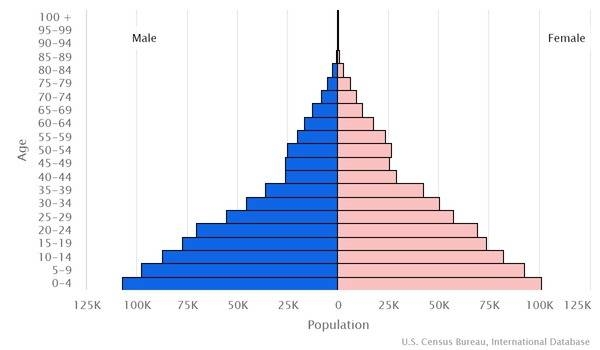
Dependency ratios
total dependency ratio: 90.3
youth dependency ratio: 59.4
elderly dependency ratio: 8.9
potential support ratio: 11.2 (2021 est.)
Median age
total: 19.6 years
male: 18.9 years
female: 20.2 years (2020 est.)
Population distribution
most of the population concentrated in the western third of the country, particularly around Dili
Urbanization
urban population: 32.5% of total population (2023)
rate of urbanization: 3.31% annual rate of change (2020-25 est.)
Major urban areas - population
281,000 DILI (capital) (2018)
Sex ratio
at birth: 1.07 male(s)/female
0-14 years: 1.06 male(s)/female
15-24 years: 1.03 male(s)/female
25-54 years: 0.93 male(s)/female
55-64 years: 0.9 male(s)/female
65 years and over: 0.79 male(s)/female
total population: 1 male(s)/female (2022 est.)
Mother's mean age at first birth
23 years (2016 est.)
note: data represents median age at first birth among women 25-49
Maternal mortality ratio
142 deaths/100,000 live births (2017 est.)
country comparison to the world: 60Infant mortality rate
total: 33.69 deaths/1,000 live births
male: 36.96 deaths/1,000 live births
female: 30.2 deaths/1,000 live births (2022 est.)
Life expectancy at birth
total population: 69.92 years
male: 68.25 years
female: 71.7 years (2022 est.)
Contraceptive prevalence rate
26.1% (2016)
Drinking water source
improved: urban: 98% of population
rural: 82.5% of population
total: 87.4% of population
unimproved: urban: 2% of population
rural: 17.5% of population
total: 12.6% of population (2020 est.)
Current health expenditure
7.2% of GDP (2019)
Physicians density
0.76 physicians/1,000 population (2020)
Sanitation facility access
improved: urban: 88.7% of population
rural: 56.1% of population
total: 66.3% of population
unimproved: urban: 11.3% of population
rural: 43.9% of population
total: 33.7% of population (2020 est.)
Major infectious diseases
degree of risk: very high (2020)
food or waterborne diseases: bacterial diarrhea, hepatitis A, and typhoid fever
vectorborne diseases: dengue fever and malaria
Alcohol consumption per capita
total: 0.41 liters of pure alcohol (2019 est.)
beer: 0.27 liters of pure alcohol (2019 est.)
wine: 0.09 liters of pure alcohol (2019 est.)
spirits: 0.05 liters of pure alcohol (2019 est.)
other alcohols: 0 liters of pure alcohol (2019 est.)
Tobacco use
total: 39.2% (2020 est.)
male: 67.6% (2020 est.)
female: 10.8% (2020 est.)
Child marriage
women married by age 15: 2.6%
women married by age 18: 14.9%
men married by age 18: 1.2% (2016 est.)
Literacy
definition: age 15 and over can read and write
total population: 68.1%
male: 71.9%
female: 64.2% (2018)
Youth unemployment rate (ages 15-24)
total: 13.2%
male: 10.9%
female: 15.9% (2016 est.)
People - note
one of only two predominantly Christian nations in Southeast Asia, the other being the Philippines
Environment
Environment - current issues
air pollution and deterioration of air quality; greenhouse gas emissions; water quality, scarcity, and access; land and soil degradation; forest depletion; widespread use of slash and burn agriculture has led to deforestation and soil erosion; loss of biodiversity
Environment - international agreements
party to: Biodiversity, Climate Change, Climate Change-Kyoto Protocol, Climate Change-Paris Agreement, Desertification, Law of the Sea, Ozone Layer Protection
signed, but not ratified: Comprehensive Nuclear Test Ban
Air pollutants
particulate matter emissions: 17.88 micrograms per cubic meter (2016 est.)
carbon dioxide emissions: 0.5 megatons (2016 est.)
methane emissions: 4.74 megatons (2020 est.)
Climate
tropical; hot, humid; distinct rainy and dry seasons
Land use
agricultural land: 25.1% (2018 est.)
arable land: 10.1% (2018 est.)
permanent crops: 4.9% (2018 est.)
permanent pasture: 10.1% (2018 est.)
forest: 49.1% (2018 est.)
other: 25.8% (2018 est.)
Urbanization
urban population: 32.5% of total population (2023)
rate of urbanization: 3.31% annual rate of change (2020-25 est.)
Revenue from forest resources
forest revenues: 0.13% of GDP (2018 est.)
country comparison to the world: 108Major infectious diseases
degree of risk: very high (2020)
food or waterborne diseases: bacterial diarrhea, hepatitis A, and typhoid fever
vectorborne diseases: dengue fever and malaria
Waste and recycling
municipal solid waste generated annually: 63,875 tons (2016 est.)
Total water withdrawal
municipal: 99 million cubic meters (2017 est.)
industrial: 2 million cubic meters (2017 est.)
agricultural: 1.071 billion cubic meters (2017 est.)
Total renewable water resources
8.215 billion cubic meters (2017 est.)
Government
Country name
conventional long form: Democratic Republic of Timor-Leste
conventional short form: Timor-Leste
local long form: Republika Demokratika Timor Lorosa'e (Tetum)/ Republica Democratica de Timor-Leste (Portuguese)
local short form: Timor Lorosa'e (Tetum)/ Timor-Leste (Portuguese)
former: East Timor, Portuguese Timor
etymology: timor" derives from the Indonesian and Malay word "timur" meaning "east"; "leste" is the Portuguese word for "east", so "Timor-Leste" literally means "Eastern-East"; the local [Tetum] name "Timor Lorosa'e" translates as "East Rising Sun"
note: pronounced TEE-mor LESS-tay
Government type
semi-presidential republic
Capital
name: Dili
geographic coordinates: 8 35 S, 125 36 E
time difference: UTC+9 (14 hours ahead of Washington, DC, during Standard Time)
Administrative divisions
12 municipalities (municipios, singular municipio) and 1 special adminstrative region* (regiao administrativa especial); Aileu, Ainaro, Baucau, Bobonaro (Maliana), Covalima (Suai), Dili, Ermera (Gleno), Lautem (Lospalos), Liquica, Manatuto, Manufahi (Same), Oe-Cusse Ambeno* (Pante Macassar), Viqueque
note: administrative divisions have the same names as their administrative centers (exceptions have the administrative center name following in parentheses)
Independence
20 May 2002 (from Indonesia); note - 28 November 1975 was the date independence was proclaimed from Portugal; 20 May 2002 was the date of international recognition of Timor-Leste's independence from Indonesia
National holiday
Restoration of Independence Day, 20 May (2002); Proclamation of Independence Day, 28 November (1975)
Constitution
history: drafted 2001, approved 22 March 2002, entered into force 20 May 2002
amendments: proposed by Parliament and parliamentary groups; consideration of amendments requires at least four-fifths majority approval by Parliament; passage requires two-thirds majority vote by Parliament and promulgation by the president of the republic; passage of amendments to the republican form of government and the flag requires approval in a referendum
Legal system
civil law system based on the Portuguese model; note - penal and civil law codes to replace the Indonesian codes were passed by Parliament and promulgated in 2009 and 2011, respectively
International law organization participation
accepts compulsory ICJ jurisdiction with reservations; accepts ICCt jurisdiction
Citizenship
citizenship by birth: no
citizenship by descent only: at least one parent must be a citizen of Timor-Leste
dual citizenship recognized: no
residency requirement for naturalization: 10 years
Suffrage
17 years of age; universal
Executive branch
chief of state: President José RAMOS-HORTA (since May 2022); note - the president is commander in chief of the military and is able to veto legislation, dissolve parliament, and call national elections
head of government: Prime Minister Taur Matan RUAK (since 22 June 2018)
cabinet: the governing coalition in the Parliament proposes cabinet member candidates to the prime minister, who presents these recommendations to the President of the Republic for swearing in
elections/appointments: president directly elected by absolute majority popular vote in 2 rounds if needed for a 5-year term (eligible for a second term); last election held in April 2022; following parliamentary elections, the president appoints the leader of the majority party or majority coalition as the prime minister
election results: 2022: José RAMOS-HORTA elected president in a run-off election - RAMOS-HORTA (CNRT) 62.1%, Francisco GUTERRES (FRETILIN) 37.9%
2017: Francisco GUTERRES (FRETILIN) 57.1%, António da CONCEICAO (PD) 32.46%
Legislative branch
description: unicameral National Parliament (65 seats; members directly elected in a single nationwide constituency by closed, party-list proportional representation vote using the D'Hondt method to serve 5-year terms)
elections: last held on 12 May 2018 (next to be held in July 2023)
election results: percent of vote by party - AMP - 49.6%, FRETILIN 34.2%, PD 8.1%, DDF 5.5%, other 2.6%; seats by party - AMP 34, FRETILIN 23, PD 5, DDF 3; composition - men 39, women 26, percent of women 40%
Judicial branch
highest court(s): Court of Appeals (consists of the court president and NA judges)
judge selection and term of office: court president appointed by the president of the republic from among the other court judges to serve a 4-year term; other court judges appointed - 1 by the Parliament and the others by the Supreme Council for the Judiciary, a body chaired by the court president and that includes mostly presidential and parliamentary appointees; other judges serve for life
subordinate courts: Court of Appeal; High Administrative, Tax, and Audit Court; district courts; magistrates' courts; military courts
note: the UN Justice System Programme, launched in 2003 and being rolled out in 4 phases through 2018, is helping strengthen the country's justice system; the Programme is aligned with the country's long-range Justice Sector Strategic Plan, which includes legal reforms
Political parties and leaders
Democratic Party or PD [Mariano Assanami SABINO Lopes]
Frenti-Mudanca (Front for National Reconstruction of Timor-Leste - Change) or FM [Jose Luis GUTERRES]
Kmanek Haburas Unidade Nasional Timor Oan or KHUNTO [Armanda BERTA DOS SANTOS]
National Congress for Timorese Reconstruction or CNRT [Kay Rala Xanana GUSMAO]
People's Liberation Party or PLP [Taur Matan RUAK]
Revolutionary Front of Independent Timor-Leste or FRETILIN [Mari ALKATIRI]
Timorese Democratic Union or UDT [Gilman SANTOS]
International organization participation
ACP, ADB, AOSIS, ARF, ASEAN (observer), CPLP, EITI (compliant country), FAO, G-77, IBRD, ICAO, ICCt, ICRM, IDA, IFAD, IFC, IFRCS, ILO, IMF, IMO, Interpol, IOC, IOM, IPU, ITU, MIGA, NAM, OPCW, PIF (observer), UN, UNCTAD, UNESCO, UNIDO, Union Latina, UNWTO, UPU, WCO, WHO, WMO
Diplomatic representation in the US
chief of mission: Ambassador Isilio Antonio De Fatima COELHO DA SILVA (since 6 January 2020)
chancery: 4201 Connecticut Avenue NW, Suite 504, Washington, DC 20008
telephone: [1] (202) 966-3202
FAX: [1] (202) 966-3205
email address and website:
info@timorlesteembassy.org
http://www.timorlesteembassy.org/
Diplomatic representation from the US
chief of mission: Ambassador (vacant), Charge d'Affaires Thomas DALEY (since August 2021)
embassy: Avenida de Portugal, Praia dos Coqueiros, Dili
mailing address: 8250 Dili Place, Washington, DC 20521-8250
telephone: (670) 332-4684, (670) 330-2400
FAX: (670) 331-3206
email address and website:
ConsDili@state.gov
https://tl.usembassy.gov/
Flag description
red with a black isosceles triangle (based on the hoist side) superimposed on a slightly longer yellow arrowhead that extends to the center of the flag; a white star - pointing to the upper hoist-side corner of the flag - is in the center of the black triangle; yellow denotes the colonialism in Timor-Leste's past, black represents the obscurantism that needs to be overcome, red stands for the national liberation struggle; the white star symbolizes peace and serves as a guiding light
National symbol(s)
Mount Ramelau; national colors: red, yellow, black, white
National anthem
name: "Patria" (Fatherland)
lyrics/music: Fransisco Borja DA COSTA/Afonso DE ARAUJO
note: adopted 2002; the song was first used as an anthem when Timor-Leste declared its independence from Portugal in 1975; the lyricist, Francisco Borja DA COSTA, was killed in the Indonesian invasion just days after independence was declared
Economy
Economic overview
Since independence in 1999, Timor-Leste has faced great challenges in rebuilding its infrastructure, strengthening the civil administration, and generating jobs for young people entering the work force. The development of offshore oil and gas resources has greatly supplemented government revenues. This technology-intensive industry, however, has done little to create jobs in part because there are no production facilities in Timor-Leste. Gas is currently piped to Australia for processing, but Timor-Leste has expressed interest in developing a domestic processing capability.
In June 2005, the National Parliament unanimously approved the creation of the Timor-Leste Petroleum Fund to serve as a repository for all petroleum revenues and to preserve the value of Timor-Leste's petroleum wealth for future generations. The Fund held assets of $16 billion, as of mid-2016. Oil accounts for over 90% of government revenues, and the drop in the price of oil in 2014-16 has led to concerns about the long-term sustainability of government spending. Timor-Leste compensated for the decline in price by exporting more oil. The Ministry of Finance maintains that the Petroleum Fund is sufficient to sustain government operations for the foreseeable future.
Annual government budget expenditures increased markedly between 2009 and 2012 but dropped significantly through 2016. Historically, the government failed to spend as much as its budget allowed. The government has focused significant resources on basic infrastructure, including electricity and roads, but limited experience in procurement and infrastructure building has hampered these projects. The underlying economic policy challenge the country faces remains how best to use oil-and-gas wealth to lift the non-oil economy onto a higher growth path and to reduce poverty.
Real GDP (purchasing power parity)
$4.19 billion (2020 est.)
$4.59 billion (2019 est.)
$3.87 billion (2018 est.)
note: data are in 2017 dollars
Real GDP growth rate
-4.6% (2017 est.)
5.3% (2016 est.)
4% (2015 est.)
Real GDP per capita
$3,200 (2020 est.)
$3,600 (2019 est.)
$3,100 (2018 est.)
note: data are in 2017 dollars
GDP (official exchange rate)
$2.775 billion (2017 est.)
note: non-oil GDP
Inflation rate (consumer prices)
0.6% (2017 est.)
-1.3% (2016 est.)
GDP - composition, by sector of origin
agriculture: 9.1% (2017 est.)
industry: 56.7% (2017 est.)
services: 34.4% (2017 est.)
GDP - composition, by end use
household consumption: 33% (2017 est.)
government consumption: 30% (2017 est.)
investment in fixed capital: 10.6% (2017 est.)
investment in inventories: 0% (2017 est.)
exports of goods and services: 78.4% (2017 est.)
imports of goods and services: -52% (2017 est.)
Agricultural products
rice, maize, vegetables, coffee, roots/tubers nes, other meats, cassava, pork, beans, mangoes/guavas
Industries
printing, soap manufacturing, handicrafts, woven cloth
Labor force - by occupation
agriculture: 41%
industry: 13%
services: 45.1% (2013)
Youth unemployment rate (ages 15-24)
total: 13.2%
male: 10.9%
female: 15.9% (2016 est.)
Population below poverty line
41.8% (2014 est.)
Gini Index coefficient - distribution of family income
28.7 (2014 est.)
38 (2002 est.)
Household income or consumption by percentage share
lowest 10%: 4%
highest 10%: 27% (2007)
Budget
revenues: 300 million (2017 est.)
expenditures: 2.4 billion (2017 est.)
Fiscal year
calendar year
Current account balance
-$284 million (2017 est.)
-$544 million (2016 est.)
Exports
$60 million (2020 est.) note: data are in current year dollars
$120 million (2019 est.) note: data are in current year dollars
$120 million (2018 est.) note: data are in current year dollars
Exports - partners
Singapore 51%, China 20%, Japan 9%, Indonesia 6% (2019)
Exports - commodities
crude petroleum, natural gas, coffee, various vegetables, scrap iron (2019)
Imports
$850 million (2020 est.) note: data are in current year dollars
$1.04 billion (2019 est.) note: data are in current year dollars
$1.06 billion (2018 est.) note: data are in current year dollars
Imports - partners
Indonesia 39%, China 27%, Singapore 10%, Malaysia 5% (2019)
Imports - commodities
refined petroleum, cars, cement, delivery trucks, motorcycles (2019)
Reserves of foreign exchange and gold
$544.4 million (31 December 2017 est.)
$437.8 million (31 December 2015 est.)
note: excludes assets of approximately $9.7 billion in the Petroleum Fund (31 December 2010)
Debt - external
$311.5 million (31 December 2014 est.)
$687 million (31 December 2013 est.)
Exchange rates
the US dollar is used
Energy
Electricity access
electrification - total population: 85.6% (2018)
electrification - urban areas: 100% (2018)
electrification - rural areas: 79.2% (2018)
Electricity
installed generating capacity: 284,000 kW (2020 est.)
consumption: -103 million kWh (2019 est.)
exports: 0 kWh (2019 est.)
imports: 0 kWh (2019 est.)
transmission/distribution losses: 103 million kWh (2019 est.)
Electricity generation sources
fossil fuels: 100% of total installed capacity (2020 est.)
nuclear: 0% of total installed capacity (2020 est.)
solar: 0% of total installed capacity (2020 est.)
wind: 0% of total installed capacity (2020 est.)
hydroelectricity: 0% of total installed capacity (2020 est.)
tide and wave: 0% of total installed capacity (2020 est.)
geothermal: 0% of total installed capacity (2020 est.)
biomass and waste: 0% of total installed capacity (2020 est.)
Coal
production: 0 metric tons (2020 est.)
consumption: 0 metric tons (2020 est.)
exports: 0 metric tons (2020 est.)
imports: 0 metric tons (2020 est.)
proven reserves: 0 metric tons (2019 est.)
Petroleum
total petroleum production: 14,000 bbl/day (2021 est.)
refined petroleum consumption: 3,500 bbl/day (2019 est.)
crude oil and lease condensate exports: 32,900 bbl/day (2018 est.)
crude oil and lease condensate imports: 0 bbl/day (2018 est.)
crude oil estimated reserves: 0 barrels (2021 est.)
Natural gas
production: 5,104,670,000 cubic meters (2019 est.)
consumption: 0 cubic meters (2021 est.)
exports: 5,104,670,000 cubic meters (2019 est.)
imports: 0 cubic meters (2021 est.)
proven reserves: 0 cubic meters (2021 est.)
Carbon dioxide emissions
538,000 metric tonnes of CO2 (2019 est.)
from coal and metallurgical coke: 0 metric tonnes of CO2 (2019 est.)
from petroleum and other liquids: 538,000 metric tonnes of CO2 (2019 est.)
from consumed natural gas: 0 metric tonnes of CO2 (2019 est.)
Energy consumption per capita
5.74 million Btu/person (2019 est.)
country comparison to the world: 168Communications
Telephones - fixed lines
total subscriptions: 2,012 (2020 est.)
subscriptions per 100 inhabitants: (2020 est.) less than 1
Telephones - mobile cellular
total subscriptions: 1,425,260 (2019)
subscriptions per 100 inhabitants: 110.22 (2019)
Telecommunication systems
general assessment: Timor-Leste has been moving forward with the regeneration of its economy and rebuilding key infrastructure, including telecommunications networks, that were destroyed during the years of civil unrest; fixed-line and fixed broadband penetration in Timor-Leste remains extremely low, mainly due to the limited fixed-line infrastructure and the proliferation of mobile connectivity; in an effort to boost e-government services; the number of subscribers through to 2026 is expected to develop steadily, though from a low base; by August 2020, Timor-Leste had three telecom service providers who jointly achieved a 98% network coverage nationally; the mobile broadband market is still at an early stage of development, strong growth is predicted over the next five years; at the end of 2020, the government issued new policy guidelines to maximize the use of spectrum in Timor-Leste; it invited mobile operators to submit applications for the allocation of spectrum in the 1800MHz, 2300MHz and 2600MHz bands; in November 2020, the government approved the deployment of a submarine fiber link connecting the south of the country to Australia via the North Western Cable System (NWCS) (2021)
domestic: system suffered significant damage during the violence associated with independence; limited fixed-line services, less than 1 per 100 and mobile-cellular services are now available in urban and most rural areas with teledensity of over 104 per 100 (2020)
international: country code - 670; international service is available; partnership with Australia telecom companies for potential deployment of a submarine fiber-optic link (NWCS); geostationary earth orbit satellite
note: the COVID-19 pandemic continues to have a significant impact on production and supply chains globally; since 2020, some aspects of the telecom sector have experienced a downturn, particularly in mobile device production; progress toward 5G implementation has resumed, as well as upgrades to infrastructure; consumer spending on telecom services has increased due to the surge in demand for capacity and bandwidth; the crucial nature of telecom services as a tool for work and school from home is still evident, and the spike in this area has seen growth opportunities for development of new tools and increased services
Broadcast media
7 TV stations (3 nationwide satellite coverage; 2 terrestrial coverage, mostly in Dili; 2 cable) and 21 radio stations (3 nationwide coverage) (2019)
Internet users
total: 382,348 (2020 est.)
percent of population: 29% (2020 est.)
Broadband - fixed subscriptions
total: 75 (2020 est.)
subscriptions per 100 inhabitants: 0.01 (2020 est.)
Transportation
National air transport system
number of registered air carriers: 2 (2020)
inventory of registered aircraft operated by air carriers: 2
Airports - with paved runways
total: 2
2,438 to 3,047 m: 1
1,524 to 2,437 m: 1 (2021)
Airports - with unpaved runways
total: 4
914 to 1,523 m: 2
under 914 m: 2 (2021)
Heliports
8 (2021)
Roadways
total: 6,040 km (2008)
paved: 2,600 km (2008)
unpaved: 3,440 km (2008)
Ports and terminals
major seaport(s): Dili
Military and Security
Military and security forces
Timor-Leste Defense Force (Falintil-Forcas de Defesa de Timor-L'este, Falintil (F-FDTL)): Joint Headquarters with Land, Air, Naval, Service Support, and Education/Training components; Ministry of Interior: National Police (Polícia Nacional de Timor-Leste, PNTL) (2022)
Military expenditures
1.8% of GDP (2021 est.)
1.8% of GDP (2020 est.)
1.7% of GDP (2019 est.) (approximately $45 million)
1.3% of GDP (2018 est.) (approximately $30 million)
1.6% of GDP (2017 est.) (approximately $35 million)
Military and security service personnel strengths
approximately 2,000 personnel (2022)
Military equipment inventories and acquisitions
the military is lightly armed and has a limited inventory consisting of equipment donated by other countries; since 2010 it has received small amounts of material from China, South Korea, and the US (2022)
Military service age and obligation
18 years of age for voluntary military service; compulsory service was authorized in 2020 for men and women aged 18-30 for 18 months of service, but the level of implementation is unclear (2021)
Military - note
since achieving independence, Timor-Leste has received security assistance from or has made defense cooperation arrangements with Australia, China, Indonesia, Malaysia, New Zealand, the Philippines, Portugal, the UN, and the US; some F-FDTL personnel train with the Indonesian military and the two countries maintain a joint Border Security Task Force to jointly monitor and patrol the border, particularly the Oecussi exclave area where smuggling and trafficking are prevalent (2022)
Transnational Issues
Disputes - international
Timor-Leste-Australia: Timor-Leste and Australia reached agreement on a treaty delimiting a permanent maritime boundary in March 2018; both countries ratified the treaty in August 2019
Timor-Leste-Indonesia: three stretches of land borders with Indonesia have yet to be delimited, two of which are in the Oecussi exclave area, and no maritime or Economic Exclusion Zone boundaries have been established between the countries; maritime boundaries with Indonesia remain unresolved; between 2005 and 2015, 500 border landmarks were placed and another 200 were proposed
